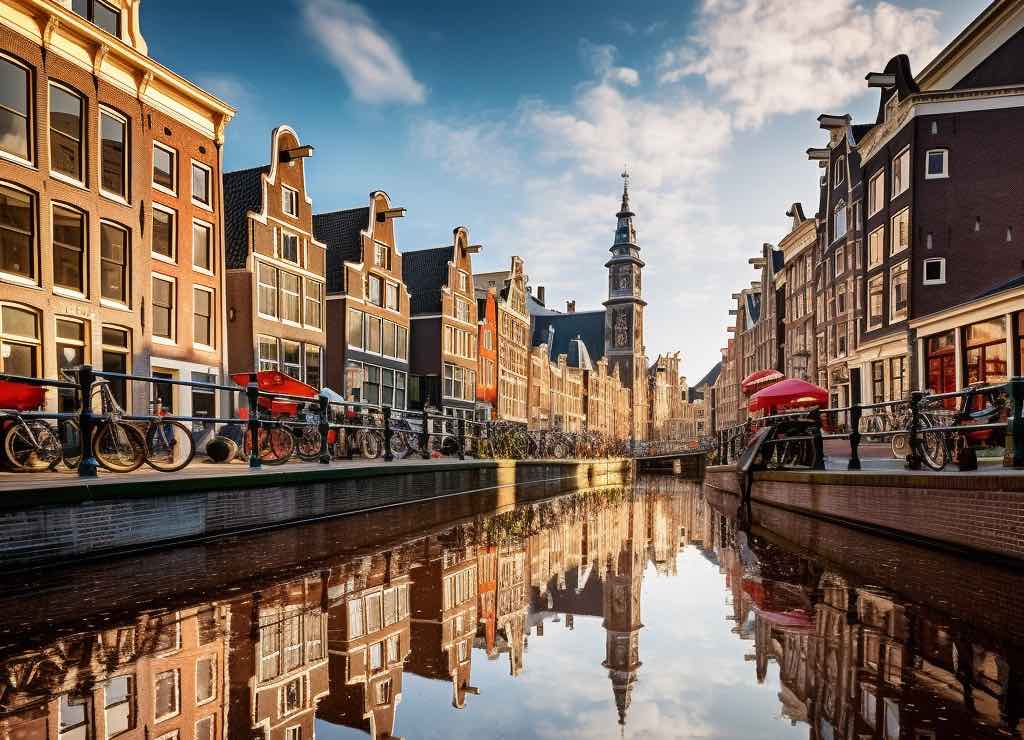Amsterdam Currency: A Complete 2024 Guide
Posted on: January 2, 2024

Amsterdam Currency 2024: Navigating the City’s Financial Landscape
Navigating Amsterdam currency in 2024 is key to unlocking the full potential of your visit to this enchanting city. As the vibrant heart of the Netherlands, Amsterdam not only boasts picturesque canals and rich cultural heritage but also a dynamic financial landscape. Whether it’s your first visit or you’re a returning admirer, understanding the nuances of Amsterdam’s currency system is crucial. This city, famous for its historic architecture and bustling markets, requires a savvy approach to financial transactions to fully enjoy everything from a leisurely coffee in a quaint café to the excitement of shopping for unique finds.
Amsterdam’s status as a premier tourist destination makes it more important than ever to be well-informed about its currency. How you manage your finances here can greatly affect your travel experience, influencing everything from where you dine to what souvenirs you bring home.
In this blog post, we dive into the top 10 things you need to know about Amsterdam’s currency in 2024. From understanding the latest digital payment trends to mastering currency exchange, we’ve got you covered.
Picture yourself wandering through Amsterdam’s charming streets, confidently handling every financial interaction. With this guide, you’ll not only become proficient in using Euros but also adept at navigating the city’s shift towards digital payments, ensuring a smooth and memorable trip.
Continue reading to gain these essential insights. Prepare for an extraordinary journey in Amsterdam, where your knowledge of the local currency will enhance every aspect of your adventure.
10 Things You Need To Know About Amsterdam Currency
- Currency Type: Amsterdam uses the Euro (€) as its official currency.
- Banknote Denominations: Available in 5, 10, 20, 50, 100, 200, and 500 euros.
- Coin Denominations: Includes 1, 2, 5, 10, 20, 50 cents, and 1 and 2 euros.
- Cash vs Digital: Both cash and digital payments are widely accepted.
- ATM Availability: ATMs are abundant and compatible with international cards.
- Currency Exchange: Best rates at banks and major transport hubs.
- Tipping Culture: Tipping is customary but not obligatory, usually 5-10%.
- Security Features: Euro notes have advanced anti-counterfeiting measures.
- Card Acceptance: Credit and debit cards are widely accepted, but have some cash.
- Cultural Transition: Switch from Dutch Guilder to Euro in 2002 marked a significant cultural shift.
Current Currency Used in Amsterdam
Amsterdam, like much of the Netherlands, primarily uses the Euro (€) as its official currency. Introduced in 2002, the Euro has since become a significant part of European trade and economics. In 2024, tourists and residents in Amsterdam will encounter Euro banknotes and coins in various denominations. Banknotes come in 5, 10, 20, 50, 100, 200 and 500 Euro values, each with distinct colors and sizes for easy recognition. The coins are in denominations of 1, 2, 5, 10, 20, and 50 cents, and 1 and 2 Euro. Each coin and note is uniquely designed, featuring different European architectural styles across various periods, symbolizing the unity and diversity of Europe. Understanding the denominations and their physical characteristics can be crucial for visitors to manage their finances effectively while in Amsterdam.
Currency Exchange Tips
Navigating currency exchange in Amsterdam requires some know-how to ensure you’re getting the best deal. In 2024, numerous currency exchange offices can be found around major tourist areas and transport hubs like Schiphol Airport and Amsterdam Centraal Station. However, it’s essential to be aware of the exchange rates and commissions charged. Often, banks offer better rates compared to standalone exchange kiosks. Another tip is to avoid exchanging money at hotels due to typically unfavorable rates. It’s also wise to compare rates online and consider exchanging a portion of your money before traveling. Some travelers opt for pre-paid travel cards available from banks, which can offer competitive rates and reduce the need to carry large amounts of cash.
Cash vs. Digital Payments
The payment landscape in Amsterdam, as of 2024, reflects a blend of traditional and modern practices. While cash is still widely accepted, there is a noticeable shift towards digital payments. Contactless card payments and mobile payment apps have become increasingly prevalent in restaurants, shops, and even in markets. For travelers, it’s crucial to have a mix of payment options. While larger establishments readily accept digital payments, smaller shops or local markets might prefer cash. It’s always advisable to carry some cash for small purchases. Understanding the balance between cash and digital payments in Amsterdam can significantly enhance the convenience of transactions during your stay.
ATM and Banking Services
ATMs are widely available throughout Amsterdam, offering convenient access to cash for both locals and tourists. Most ATMs in the city support major international credit and debit cards, making withdrawals straightforward. However, it’s essential to be aware of potential fees for international transactions. These can vary depending on your bank’s policies and the ATM’s operating bank. In 2024, several international banks have branches in Amsterdam, providing full banking services to their customers. It’s advisable to inform your home bank of your travel plans to prevent any unexpected card blocks due to foreign transactions. Additionally, keeping an eye on the daily withdrawal limits and planning your banking needs accordingly can help avoid any inconveniences.
Cultural Tips Related to Money
Understanding the local money-related customs and etiquettes can enhance your experience in Amsterdam. Tipping, for instance, is customary but not mandatory in the Netherlands. In restaurants and cafes, it’s common to leave a small tip, typically around 5-10% of the bill, if the service is satisfactory. However, tipping in other services like taxis or hairdressers is less common and is usually a matter of personal choice. Bargaining is not a standard practice in Dutch stores or markets, so prices are generally considered fixed. However, at flea markets or when purchasing art or antiques, some negotiation might be acceptable. Being aware of these cultural nuances related to money can help avoid any social faux pas and ensure a smooth experience while shopping or dining in Amsterdam.
Frequently Asked Questions
What is the currency used in Amsterdam in 2024?
In 2024, Amsterdam uses the Euro (€) as its official currency. It includes banknotes in denominations of 5, 10, 20, 50, 100, 200, and 500 euros, and coins in 1, 2, 5, 10, 20, and 50 cents, and 1 and 2 euros.
Where is the best place to exchange currency in Amsterdam?
The best places for currency exchange in Amsterdam are banks and specialized currency exchange offices in major tourist areas and transport hubs like Schiphol Airport and Amsterdam Centraal Station. Banks usually offer more favorable rates compared to standalone kiosks.
Are credit cards widely accepted in Amsterdam?
Yes, credit cards are widely accepted in Amsterdam as of 2024, especially in hotels, restaurants, and larger stores. However, it’s advisable to carry some cash for smaller shops and local markets.
Can I use digital payments in Amsterdam?
Digital payments, including contactless card payments and mobile payment apps, are increasingly popular in Amsterdam. They are accepted in many establishments, though cash remains a viable option for smaller transactions.
Are there any ATMs in Amsterdam where I can withdraw cash?
Amsterdam has a dense network of ATMs that support major international credit and debit cards, making it convenient to withdraw cash across the city. Be aware of potential fees for international transactions.
What are the tipping customs in Amsterdam?
Tipping in Amsterdam is customary but not mandatory. In restaurants and cafes, a tip of around 5-10% of the bill is common if the service is good. Tipping in other services like taxis is less common and is usually at the customer’s discretion.
Is the currency used in Amsterdam’s Red Light District different from the rest of the city?
No, the currency used in Amsterdam’s Red Light District is the same as the rest of the city, which is the Euro (€). Just like in other parts of Amsterdam, both cash and digital payments are accepted in the Red Light District, but it’s advisable to carry some cash as sex workers and smaller establishments might not accept cards.
In exploring the intricacies of Amsterdam’s currency, an intriguing aspect to consider is how it plays into the diverse facets of the city’s culture and economy, particularly in areas like the Red Light District. Understanding the dynamics of currency becomes even more relevant when you delve into specific sectors of Amsterdam’s vibrant urban landscape. For those interested in a deeper insight into how the Euro impacts various services and experiences, including those in the Red Light District, a comprehensive guide to the Red Light District cost offers a detailed perspective. This guide not only sheds light on the monetary aspects but also provides a broader understanding of the economic framework of one of Amsterdam’s most famous and historic areas.
Amsterdam Currency Facts
- Polymer Notes Introduction: While traditionally made from cotton paper, the Eurozone has been considering the introduction of polymer notes for future Euro banknotes. Polymer notes, already used by several countries, are more durable and resistant to wear and tear compared to paper notes.
- Smallest and Largest Denominations: The smallest denomination of the Euro currency is the 1 cent coin, while the largest is the 500 Euro banknote. However, the 500 Euro note is no longer being issued since January 27, 2019, due to concerns about its use in illicit activities, though it remains legal tender.
- Euro Symbol Origin: The Euro symbol (€) is inspired by the Greek letter epsilon (Ε), reflecting the cradle of European civilization, and the first letter of the word ‘Europe’. The two parallel lines signify the stability of the Euro.
- Exchange Rate Impact: The Euro’s value against other currencies, particularly the US Dollar, has a significant impact on Amsterdam’s tourism and trade. A stronger Euro can make Amsterdam more expensive for tourists, while a weaker Euro can boost tourism and exports.
- Legal Tender Status: Euro banknotes and coins are legal tender across the Eurozone. This means they must be accepted for most types of transactions, although there are exceptions for certain types of payments or where the exact change cannot be given.
- Cultural Impact: The adoption of the Euro in Amsterdam and other Dutch cities marked a cultural shift, moving away from the Dutch Guilder, which had been in use since the 17th century. The transition to the Euro was a significant moment, reflecting deeper European integration and cooperation.



